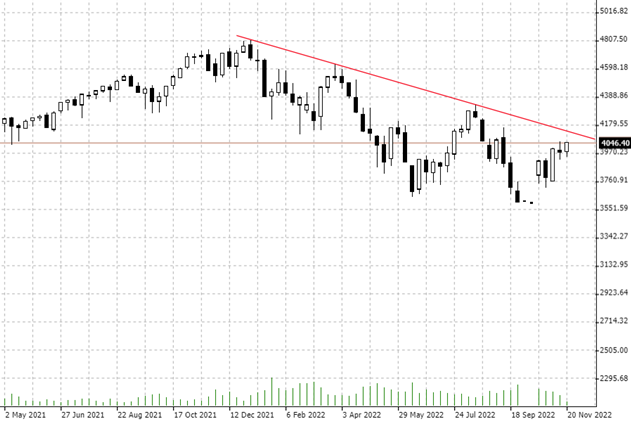

24.11.2022 – A small gift for Thanksgiving: the Federal Reserve shows itself to be tame. Although nothing is usually given away on this feast. The bulls gratefully accept the gift. But one expert fears that the end of the party is approaching. And that it is better to dance at the exit.
If we look at the weekly chart in the S&P 500, we can see that the moment of truth is coming soon. Namely, when the index reaches the red trend line. Rebound or breakthrough? We will see.

Source: Bernstein Bank GmbH
The blog “The Market Ear” advised its readers to “Keep dancing…but closer to the exit”. Meaning: let the profits run, but be prepared for a setback. And if necessary, quickly leave the room if it gets queasy. Specifically, the experts just wrote that the current setup is very much like the “Summer Squeeze”.
Trend reversal at 4,100?
Now the people of “The Market Ear” are waiting for the SPX to reach the 200-day average and then the “classical overshoot that forced people in” would set in. And the blog also called the signal to exit very specific: “If we are to “replicate” the squeeze move from summer lows to highs, then the overshoot would play out perfectly (3500*17% = around 4100).”
The authors further referred to an analysis by Binky Chadha of Deutsche Bank. The team was already bullish for a bear market rally because of money flows on Wall Street and stock buybacks in early October, they said. It’s not yet time to ditch the buying bias, he said: “Positioning returning to neutral should see the S&P 500 up by 6 to 7%.”
Pleased with the Fed
Meanwhile, there was boost from the Federal Reserve. The market took the Federal Open Market Committee (FOMC) minutes as mostly bullish. According to the FOMC Minutes, a majority of decision-makers at the central bank believe a slower pace of rate hikes is appropriate soon. This would allow the Fed to better monitor the effect of its actions. Chris Low of FHN Financial commented, “The two big headlines are most Fed officials favor slower tightening pace soon and various Fed officials see higher peak rates. Both of these confirm post-meeting press conference guidance from Powell.” And Steve Sosnick, chief strategist at Interactive Brokers, explained, “With pivot off the table, and with no pause coming yet, slower pacing seems to be enough for stock traders now.” Where the “pivot” refers to the turnaround.
Our conclusion: We are curious whether and how long the party will continue. Bernstein Bank wishes successful trades and investments!
__________________________________________________________________________________________
The content of this publication is for general information purposes only. In this context, it is neither an individual investment recommendation or advice nor an offer to purchase or sell securities or other financial products. The content in question and all the information contained therein do not in any way replace individual investor- or investment-oriented advice. No reliable forecast or indication for the future is possible with respect to any presentation or information on the present or past performance of the relevant underlying assets. All information and data presented in this publication are based on reliable sources. However, Bernstein Bank does not guarantee that the information and data contained in this publication is up-to-date, correct and complete. Securities traded on the financial markets are subject to price fluctuations. A contract for difference (CFD) is also a financial instrument with leverage effect. Against this backdrop, CFD trading involves a high risk up to the point of total loss and may not be suitable for all investors. Therefore, make sure that you have fully understood all the correlating risks. If necessary, ask for independent advice. CFDs are complex instruments and are associated with the high risk of losing money quickly because of the leverage effect. 68% of retail investor accounts lose money trading CFD with this provider. You should consider whether you understand how CFD work and whether you can afford to take the high risk of losing your money.7
